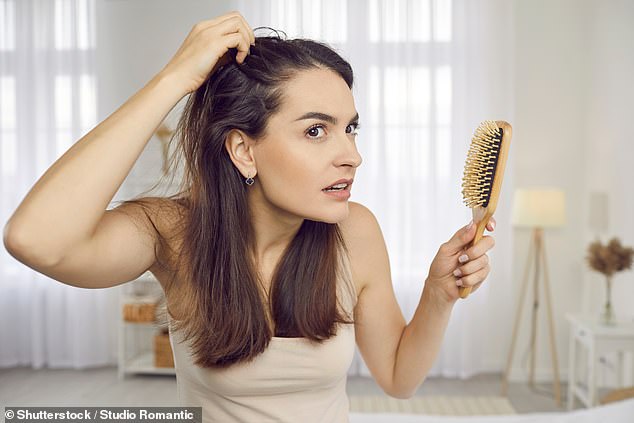If you’re concerned about the amount of hair you seem to be shedding as the temperature drops, you’re certainly not alone.
According to the NHS, 8 million women and around 6.5 million men in the UK experience hair loss of some sort.
For many, it may be subtle, with some noticing their hairbrush collecting more hair than normal. For others, it may be more extreme.
But, the experts say for the most part, this is a completely normal reaction to the change in seasons.
‘On average, we have around 100,000 hairs on our head and around 10 per cent of these will be in the shedding phase at any one time,’ explained Dr Paul Farrant, a dermatologist who specialises in hair and scalp disorders.
‘But changes in the environment—such as a temperature—can have an impact on growth cycles, which may lead to more noticable shedding in the colder months.
‘This is a phenomenon known as seasonal hair shedding, which tends to happen around September time in the UK.’
Hair grows in four distinct stages, with the final stage seeing the shedding of old hair, making room for new hair growth.

Seasonal hair shedding is thought to be part of the hair’s natural renewal process
The first three phases—anagen, catagen and telogen—cover the growth and maturation of hair and the activity of the hair follicles that produce individual hairs.
Dr Farrant continued: ‘Each hair follicle has its own timeline, meaning that from around 1 year of age each follicle will be doing its own thing.
‘When it gets towards the end of its cycle, the hair follicle shrinks and sits in a resting phase—known as telogen.
‘Hair is then shed from the scalp as the follicle elongates into the skin, forcing out the old hair to make room for new growth.
‘In seasonal hair shedding, however, there is a little bit of synchronisation, so a higher proportion of hairs stop growing at the same time.’
Whilst there is still a lot of speculation as to why this happens, Dr Farrant suspects that seasonal hair loss is actually more to do with something happening in the summer months—such as increased vitamin D exposure—that cause more hairs to enter the exogen phase at the same time when the temperature drops.
‘But, the good news is seasonal shedding is relatively short lived, lasting around 3 months, and you never lose tonnes of hair,’ he added.
And whilst the phenomenon is usually nothing to worry about, with 90 per cent of our hairs still in the growing phase whilst others are shedding, Dr Farrant warned that sometimes it can be a sign of something more serious—like pattern baldness, psoriasis, or thyroid issues.

Frequent shampooing is recommended in the summer months, where we are more prone to sweat which can cause irritation, clogged pores and even hair loss
He said: ‘Seasonal shedding tends to be fairly mild. If you have clumps of hair falling out, or patches of baldness then this could be cause for concern.
‘Similarly, if the top of your head is starting to look very thin, and you have a family history of hair loss, then you might start to worry about pattern baldness.’
Having healthy, fuller hair is largely down to genetics and hormone levels, which are largely beyond our control, Dr Farrant explained, but there are some things you can do at home to minimise your risk of breakage or drying out your scalp—both of which can contribute to seasonal shedding.
Because hair is predominately made of protein, Dr Farrant suggests eating a healthy, balanced diet rich in protein to help give your hair an added boost in the winter months.
‘Try cooking from fresh, prioritising sleep, and managing stress as all these lifestyle things will help you live a more anti-inflammatory approach to life, reducing the risk of hair loss,’ he added.
Nutritional deficiencies can also lead to hair loss he said. To that end, Dr Farrant recommends eating foods that are rich in iron, omega-3 fatty acids, zinc and folate for healthy hair growth.
And whilst it may be tempting to take a nutritional supplement for hair growth, Dr Farrant advises consulting a dermatologist in the first instance, to try and get to the root of the problem—quite literally.
‘Your hair care regime may also need to change with the seasons,’ Dr Farrant advised.
‘In the summer months we tend to sweat more, so we might need to wash our hair more often to prevent grease from building up and clogging pores
‘In the winter, our scalp tends to be a bit dryer, so we can afford to wash our hair less often, as over shampooing can strip our hair of essential oils and dry out the scalp, resulting in itchy and inflamed skin, which can in turn contribute to hair loss.’
Physical and mental stress can also contribute to hair loss, triggering conditions like alopecia areata, which occurs when the body’s immune system attacks healthy hair follicles.
‘If you’ve got persistent shedding that can’t be explained by a nutrient deficiency or thyroid issues, for example there are things that can be done, depending on the cause such platelet rich plasmas (PRP) for hair loss.’
PRP involves extracting a small amount of blood from a patient and injecting this directly into the scalp, to encourage hair growth.
The growth factors in plasma simulate the formation of new blood vessels around the hair follicles, so they are better supplied with the nutrients needed to grow.
If further tests and blood work indicate that the hair loss is hereditary, your doctor may recommend medication, such as minoxidil, which works by increasing blood flow to the root of the hair.
However, Dr Farrant warned that this only works when there is another condition happening alongside seasonal hair shedding, such as androgenetic hair loss, as patients will normally have to take the medication long term, with hair loss recurring when treatment is stopped.
